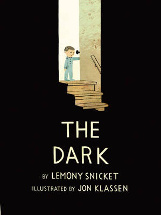The Dark by Lemony Snicket

Ill. by Jon Klassen. Orchard Books, 2013. ISBN 9781408330029.
Picture book. Laszlo is afraid of the dark. But he lives in a big
house with a creaky roof, smooth, cold windows and several flights
of stairs so there are many places that dark can hide. But mostly,
dark lives in the basement waiting in a distant corner during the
day and then coming out at night to spread itself against the
windows and doors of Laszlo's house. But Laszlo thought that if he
visited the dark in its room, it wouldn't come and visit him in his
room so each morning he would peek at it in the basement and say
hello. Until one night, it did . . .
The power of this story lies in Snicket's ability to personify the
dark as a real entity as it leads Laszlo on a journey through the
house and down, deep into the basement. It talks to Laszlo as though
it is a real character, and Laszlo's calm response, both expression
and action, helps convey the message that there is nothing to fear.
Then just as the climax is almost reached, Snicket provides an
explanation of the need for creaky roofs and blank windows, almost
as though he is trying to defuse the suspense to make it manageable
for the young reader.
Jon Klassen's illustrations help build up the suspense - a limited
palette, the use of shadow, shade and light, bare walls, uncovered
windows and empty rooms all add to the atmosphere and feed a little
boy's imagination - and, in the words of one reviewer, this is an
'inspired pairing'. This is a perfect example of a picture book
where text and illustrations work so well that each would be
diminshed without the other.
The Dark appeared regularly on the best-of lists for 2013,
particularly those in the US, and it is a gentler Snicket at work
than the one we are accustomed to. Both the US and UK
publishers have book trailers and you can listen to an audio
clip by Neil Gaiman.
This would be a great introduction to introducing the science
concepts of light and day, day and night, the rotation of the earth
and so forth so that young children begin to understand more and
fear less - another way to support the curriculum beyond the
traditional English perspective.
Barbara Braxton